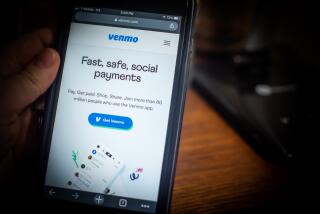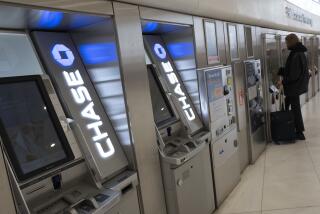U.S. Ending Ceiling on Passbook Interest but Rates Could Go Down Instead of Up
- Share via
A wealthy San Francisco socialite in her 80s keeps $1 million in a passbook savings account earning a mere 5.5% interest. Another elderly San Francisco woman keeps $190,000 in a similar passbook account. Both women reject advice to put their money into higher-paying accounts.
Michael Rinebold, a 33-year-old Woodland Hills computer consultant, also has a passbook account, with a balance of only $600. “That’s my rainy day account,” he says. “I want to be able to pull it out if I need it, if I’m short of cash.”
Rinebold and the San Francisco women, along with millions of other Americans, have one thing in common: devotion to the traditional passbook savings account.
For most of these savers--with their handy account books listing every deposit and withdrawal--the passbook account is a matter of convenience or necessity.
A Matter of Habit
But, for others, it is a matter of comfort or simple habit. Amid a bewildering array of higher-paying accounts--money-market funds, money-market savings and checking accounts and more that emerged during an environment of upheaval in the banking world--these passbook savers have resisted the siren song of high interest rates and fancy investment offerings.
“They are the true-blue loyalists who have not yet entered the 20th Century,” one banking expert quipped.
This week, however, financial deregulation reaches passbook savers whether they like it or not. Decades-old federal limits are finally being lifted on how much interest may be paid on regular savings accounts--including passbook accounts and so-called statement accounts, which pay the same 5.5% interest but provide a monthly statement instead of a passbook. Starting Tuesday, banks and savings and loan firms will be allowed to pay any interest they wish on regular savings accounts, instead of the 5.5% maximum now imposed by law.
A Long-Awaited Step
This step, long and eagerly awaited by consumer groups, is the last in a years-old process of banking deregulation intended to end Depression-era banking restrictions and allow small savers to earn market rates of interest.
The Depository Institutions Deregulation Committee, which Congress created in 1980 to dismantle savings regulations, also ceases to exist on Tuesday.
At least for now, however, the impact on passbook savers is likely to be slight. Although banks and S&Ls; are raising rates on other accounts, the vast majority plan to keep rates on their passbook and statement accounts at or below 5.5%. Most fear that raising the rates will do nothing more than lower their profits. Not enough new savers will be attracted by the higher rates, they reason, but bank and S&L; costs will rise. Many passbook and statement account holders already have other accounts earning higher interest, bankers say.
Rinebold, the computer consultant with $600 in his passbook account, says earning a percentage point or more really would not matter that much to him. “I mean you’re talking about $10 a year in added interest,” he says.
Rate May Be Lowered
Another reason that banks are not raising the passbook rate is that overall interest rates are so low; some might even lower the passbook rate if overall interest levels fall further.
“With rates going down, 5.5% is a pretty darn good rate in today’s market,” says Thomas E. Watson, a vice president of Financial Shares Corp., a Chicago-based bank consulting firm.
To be sure, more passbook savers might switch funds to other accounts if interest rates swing upward again.
Such was the case beginning in the late 1970s, when interest rates soared to double-digit levels and products that allowed savers to earn the higher rates proliferated. Money-market mutual funds offered double-digit rates on balances as low as $100. Later, in the early 1980s, banks and S&Ls; were allowed to offer checking accounts that paid 5.25% interest. Then, in late 1982 and early 1983, banks and S&Ls; were allowed to offer savings and checking accounts that paid higher money-market rates but required minimum balances.
Deposits Fell 42%
The rush out of passbook and statement accounts was on. After peaking in May, 1978, at $499.5 billion, funds in these accounts at banks and thrifts nationwide fell 42% to a low of $288.5 billion at the end of 1984, according to Federal Reserve Board data.
But now, with interest rates on other savings instruments having fallen well into single-digit levels, passbook and statement accounts are showing a mini-comeback. The amount of money in such accounts nationwide actually has increased 5.7% since the end of 1984, to $304.6 billion. Some banking experts estimate that as many as 86 million Americans have regular savings accounts. Affluent consumers are more likely to have them than lower-income consumers.
At some banks, the size of these accounts is nothing to sneeze at. Bank of America has $5 billion, or about 5.3% of its deposits, in these accounts, with an average account size of about $2,500. Security Pacific National Bank has $1.7 billion, or 5.6% of its deposits, in these accounts, with a $2,000 average size. Nationally, the average account size is $3,500, according to Fed data.
Consumer surveys find that passbook savers stick with the accounts for various reasons. Market Facts, a Chicago-based financial survey firm, says a nationwide survey in January, 1985, showed that most consumers held such accounts because it is easy to get money out in an emergency.
Unlimited Withdrawals
Passbook and statement accounts generally allow unlimited withdrawals, but money-market savings accounts limit withdrawals under certain conditions and certificates of deposit require savers to tie up money for a specified period.
Consumers said also that they kept a passbook account because of tradition.
“I’ve had one since I was a kid . . . it’s an emotional thing,” Jean Stewart, a Security Pacific vice president in charge of its passbook accounts, said. She said that she keeps between $1,000 and $2,000 in her passbook account and uses it to buy gifts for her husband so that “he doesn’t know how much I spend on his presents.”
Bankers point out that the accounts are particularly popular with elderly customers who remember the banking failures during the Depression. They mistrust money-market savings accounts, money-market funds and other savings vehicles, which they perceive as less safe.
‘A Fear of the Unknown’
“No matter what you do, you can’t convince them to switch out of their passbook accounts,” Los Angeles accountant Patricia Cain says of some of her elderly clients. One client, a Los Angeles woman in her 60s, has about $60,000 in a passbook account.
“She’s concerned about doing anything different that she’s not comfortable with and doesn’t know,” Cain said. “It’s a fear of the unknown.”
“Many of our older customers have their own set patterns which they don’t want to change,” Mary Ann Dong, a personal banking officer at Wells Fargo Bank, said. “They’re not looking for high interest rates, they’re just looking to keep what they have.”
Some have the accounts for cultural reasons. David Wong, president of United Savings & Loan Bank, based in Seattle’s predominantly Asian International District, said that 70% of his customers are of Chinese descent or are other Asian immigrants who “prefer passbook accounts over checking accounts. These old-timers and immigrants are not used to checking accounts” because their countries of origin did not have them, he says.
Of course, many other depositors have passbook accounts simply because they do not have enough money to put into higher-paying accounts.
Tiered Savings Accounts
However, despite their popularity and usefulness, passbook and statement accounts probably will not last forever--at least not in their current form, many banking experts say. These accounts eventually may be replaced by tiered money-market savings accounts that pay higher interest for higher balances.
Such accounts began to appear last Jan. 1, after another banking deregulatory move that eliminated a rule requiring $1,000 minimum balances on money-market savings and checking accounts. Such accounts now typically pay a passbook rate of 5.5% on balances below $1,000 or $2,500, and a market rate--now averaging about 6.4% nationwide--on balances above those levels.
“This essentially makes the money-market savings account the passbook account of the future,” says Robert K. Heady, publisher of Bank Rate Monitor, a North Palm Beach, Fla., newsletter.
However, banking experts say, savers with less than $1,000 to deposit may still find a passbook account a better investment than a money-market savings account. That is because many banks are charging fees on money-market accounts if the balances fall below a certain amount, usually $1,000 or $2,500. Those fees--in one case as high as $7 for each time the balance falls below the minimum level--wipe out any added gain from earning a higher rate.
“Even if you get a slightly higher interest rate (in a money-market account), the fees are going to eat you alive,” said Ken McEldowney, executive director of Consumer Action, a San Francisco consumer group that tracks savings rates statewide. He urges consumers to shop around carefully, as banks and thrifts generally have been raising fees on accounts with smaller balances.
More to Read
Inside the business of entertainment
The Wide Shot brings you news, analysis and insights on everything from streaming wars to production — and what it all means for the future.
You may occasionally receive promotional content from the Los Angeles Times.










